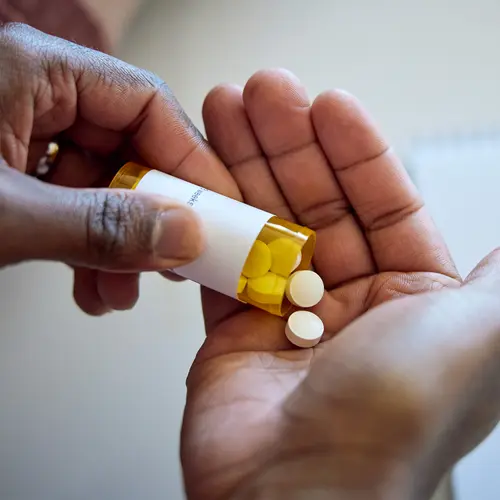Among the newer antipsychotic drugs for schizophrenia are a type called dopamine partial agonists. They get this name from the way they work in your brain. You might also hear them called dopamine-serotonin stabilizers or D2 or D3 receptor partial agonists.
Dopamine is a neurotransmitter (a chemical messenger) that affects your moods and behavior. It’s your brain’s “feel good” hormone. When you do something that makes you feel good, your brain releases dopamine. That dopamine release makes you want to repeat the thing that made you feel good.
Some people’s brains make too little dopamine. Low levels of dopamine can lead to conditions such as Parkinson’s disease or attention deficit hyperactivity disorder (ADHD). Other people’s brains make too much dopamine. Higher levels of dopamine can lead to obesity or addictions.
People with schizophrenia are thought to make too much dopamine in some areas of their brains, and too little in other areas. Too much or too little dopamine may cause schizophrenia symptoms like hallucinations, delusions, and lack of motivation.
How Do Dopamine Partial Agonists Work?
Dopamine partial agonists work by balancing dopamine levels. In areas of your brain with too much dopamine, they partially block the activity of dopamine. In areas where there’s not enough dopamine, they increase dopamine activity.
These drugs also balance serotonin activity. Serotonin is another chemical messenger in the brain. It affects mood and sleep, among other functions. Too much or too little can trigger physical and mental health problems.
Older medications known as first-generation antipsychotics don't balance dopamine activity throughout the brain. Instead, they only block dopamine activity. The newer second-generation antipsychotics also block serotonin activity.
Dopamine partial agonists are sometimes called third-generation antipsychotics. The FDA has approved these dopamine partial agonists for schizophrenia:
What Are Side Effects of Dopamine Partial Agonists?
Side effects differ between antipsychotic medications. First-generation drugs tend to cause movement disorders known as extrapyramidal symptoms. These symptoms include painful muscle contractions, restless legs, and muscle twitching. These drugs may also cause other side effects like dry mouth and sedation.
Second-generation drugs carry a lower risk of these movement symptoms. But they tend to cause weight gain and metabolic syndrome. Metabolic syndrome raises your risk of stroke, heart disease, and diabetes.
Dopamine partial agonists seem to cause less movement and muscle problems, and modest weight gain, compared to the earlier drugs. But they may have other side effects such as restlessness, known as akathisia. They can also raise the risk of death in people who have psychosis that’s related to dementia.
How Well Do They Work?
While the FDA approved aripiprazole in 2002, the others only became available in 2015. It takes time for researchers to gather information about newer drugs, especially their long-term effects. So it’s hard to compare the different dopamine partial agonists to each other. But research into partial dopamine agonists has had mostly positive results.
Researchers have had more time to study aripiprazole. One study pitted it against haloperidol (Haldol), a first-generation drug. It found that the people who took aripiprazole tolerated it better and were less likely to have side effects than those on haloperidol. Another study found aripiprazole was as effective as other first- and second-generation antipsychotic drugs, but had fewer side effects.
A review study on brexpiprazole showed that several studies found it was easy to tolerate and didn’t harm sexual function. But the researchers noted that it can be more expensive than aripiprazole, which is available as a generic.
In another study, people who took cariprazine had less side effects than those who took a placebo or risperidone (Risperdal). The study also showed that it caused few metabolism changes in those who took it, and was effective against relapses of psychosis.
What Can You Expect When You Take Them?
It can take from 2 weeks up to 3 months for these antipsychotics to reach full effectiveness. Here’s how you take each of these medications:
Aripiprazole. You can take aripiprazole as a liquid, tablet, or type of tablet that dissolves in your mouth. Or your doctor may give you a shot of it every 4 weeks. It also comes as a tablet that contains a tiny sensor that transmits information to a smartphone app about how you’re taking the medicine. If you’re prescribed tablets, you’ll probably take one once a day. It’s best to take it at the same time each day.
Brexpiprazole. You take it as a tablet once a day, starting with a low dose. Your doctor may increase your dosage depending on how well you tolerate the drug.
Cariprazine. Cariprazine comes in a capsule you take once a day. You’ll likely start with a low dose and slowly increase it depending on how well it works and your side effects.
Never stop taking any antipsychotic medication suddenly without talking to your doctor – even if you feel better. This could cause your symptoms to come back and be worse than before.
If you miss a dose, take it as soon as you can, unless it’s almost time for your next dose. Never double up on your dosage. If you miss your shot of aripiprazole, tell your doctor right away.
Other things to keep in mind:
- Don’t drink alcohol or take illicit drugs while taking an antipsychotic. It can worsen side effects and keep your medicine from working as well as it should.
- Make sure your doctor knows about any other medications you’re taking, including over-the-counter treatments, herbs, and supplements.
- Let your doctor know if you’re pregnant or plan to get pregnant.

